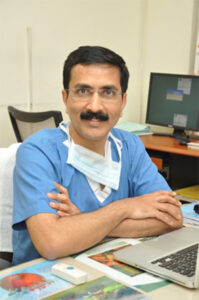- Right time to understand the advantages of Modern Technology
- Minimally Invasive heart surgery procedure also called key hole surgery is a conventional operation performed on or inside the heart using small incision with specialized instruments
- With advanced instrumentation and techniques, we perform CABG with combination of artery and veins or total arterial depending on the coronary artery lesions
DR DEVENDER SINGH
The Department of Cardiology & Cardiothoracic Surgery at renowned Medical Institutions like Tricolour Hospitals & Baroda Heart Institute & Research Centre aims to reduce the deadly consequences of cardiovascular diseases through innovative therapies for patient care. These departments are determined to provide compassionate, state-of-the art, proficient care to heart patients at an affordable cost.

Dr Devender Singh, a Senior Consultant Cardiothoracic and Vascular Surgeon at both these leading Medical Centers, has been performing minimally invasive cardiac surgery since the last ten years. The first surgeries of this type were mitral and aortic valve surgeries but now, a wide range of modern procedures can be done using minimally invasive techniques to help make recovery faster and more comfortable.
Informing more about the Operational team at these Hospitals and about the Minimally Invasive Cardiac Surgery revolution, Dr. Devender shares, “At our hospitals an interventional team is available round-the-clock to help patients with cardiac emergencies with primary and complex Coronary Angioplasties, Stenting, Pacemaker and other Devices. The units are equipped with latest technologies like FFR and IVUS. Cardiology unit has high-end Electrophysiology Lab for the diagnosis and treatment of conditions like RF ablation for abnormal rhythm. Our healthcare professionals bring the promise of unparalleled excellence in patient care, education and research.”
Minimally Invasive heart surgery procedure also called key hole surgery is a conventional operation performed on or inside the heart using small incision with specialized instruments.
An expert surgical team carefully assesses suitability of patient for minimally invasive surgery and based on several factors like the type of heart disease , how severe it is, your age, medical history , lifestyle and results of tests done before surgery, the surgeon then decides the best approach.
While traditional heart surgery uses an incision of about 6 to 8 inches long through the middle of chest, cutting the breast bone, MICS or Key hole surgery is today the safest and most commonly used incision worldwide for patient who need complicated heart surgeries, reoperation, multiple coronary artery bypass procedures or complex aortic procedures. Sometimes, minimally invasive surgery includes a partial sternotomy. This involves cutting a part of the breast bone. when possible, the surgeon can avoid cutting the breast bone and, instead, make one or more small incisions through muscles between the ribs. This technique called a mini thoracotomy.
Minimal Invasive Coronary Artery Bypass Surgery
MICS CABG surgery is today considered to be a safe and complete operation and is said to have revolutionized the way coronary surgery is performed. In this technique, the heart is approached through the side of the left chest through a small 7-8cm incision. The chest is entered between the ribs without cutting any bones and by splitting the muscles.
With advanced instrumentation and techniques, we perform CABG with combination of artery and veins or total arterial depending on the coronary artery lesions. Since there is no cutting through any bone, the patients experience less pain and the chance of infection is very low.
The benefits of minimally invasive surgery include
- Small incision
- Small scars
- Less pain
- Shorter hospital stay after surgery
- Lower risk of infection
- Lower risk of bleeding and blood transfusion
- Shorter recovery time and faster return to normal activities/work.
Recovery
Post minimally invasive surgery, patient will probably be able to go home 2 to 5 days after surgery. Our healthcare team follows the patient closely while in the hospital and help them recover as quickly as possible. When Patients are ready to leave the hospital, they will get instruction on recovery and return to work, including guidelines for activity, driving, incision care and diet.
In general, it takes about 2 to 3 weeks before patient will feel well enough to return to work (if job doesn’t involve physical activities), resume driving and take part in most non strenuous activities. Patient can usually get entirely back to normal routine in 3 weeks after surgery. It is important to know that everyone has a different recovery path.
Tips for healthy living / healthy heart….
To keep your heart healthy after surgery, it is important to make lifestyle changes and take your medications as per prescribed. Heart-healthy lifestyle changes that are important to your recovery include
- Quitting smoking
- Controlling high cholesterol
- Managing high blood pressure and diabetes
- Exercise regularly
- Maintaining a healthy weight
- Eating a heart healthy diet
- Taking part in cardiac rehabilitation program, as recommended
- Following up your doctor for regular visits.
Dr Devender Singh is a Senior Consultant Cardiothoracic and Vascular Surgeon at Tricolour Hospitals & Baroda Heart Institute & Research Centre












